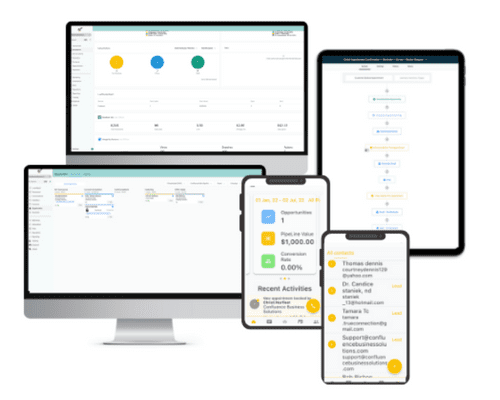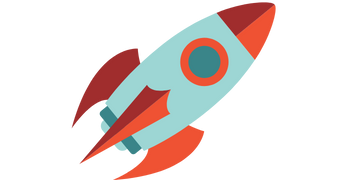
Strategies for Each Stage of Business Growth
According to this Harvard Business Review article, there are 5 stages that a business can go through. They are: Existence, Survival, Success, Take-Off and Maturity. A good CRM is imperative in every business stage in order to succeed and remain successful. Today we are taking a deep dive into each of these stages and how to maximize your CRM to produce fantastic results in each of them. The purpose of this blog is to ease some of the overwhelm small business owners feel about technology. We advise our clients to not focus on trying to learn the entire CRM all at once. Just focus on the tools that address the main challenge of the stage their business is in. This sets you and your business up to move to the next level.
First, let’s take a look at the existence stage.
The Existence Stage
A business is typically considered to be in the existence stage when it has established itself and generates some revenue. Here are 6 more signs that a business is in the existence stage
- Main challenge: Obtaining customers, delivering the product and keeping adequate cash flow.
- Revenue: The business has established a stream of revenue.
- Established customer base: The business has a customer base that provides a source of income.
- Limited resources: The business has limited resources, such as funding, personnel, and technology, which limits its ability to grow and expand.
- Focused on cost-cutting: The business is focused on reducing costs in order to gain profitability.
- Offers: The business is still perfecting exactly what their offer is.
Four ways to maximize your CRM to get off to a strong start
- Lead Segmentation: A good CRM has the ability to segment leads based on demographics, behaviors, and interests, allowing small businesses to create targeted marketing campaigns and personalize their interactions with potential customers.
- Lead Scoring: Score leads based on factors such as engagement and behavior, allowing you to prioritize your efforts and focus on the most promising leads.
- Automation: Integrate your CRM with additional marketing automation tools to automate repetitive tasks and streamline your marketing efforts. This includes lead nurturing campaigns, email marketing, and social media marketing.
- Reporting and Analytics: Detailed reporting and analytics allows small businesses to track the effectiveness of their lead generation efforts and make informed decisions about future marketing strategies.
Secondly, we discuss the survival stage.
The Survival Stage
A business that is expanding its operations, increasing its customer base and generating higher profits is in this stage. Additionally, the following are 5 signs that a business is in the survival stage:
- Main challenge: Revenue vs. expenses. What can the business do to generate/increase profit?
- Increased sales and revenue: The business experiences growth in its sales and revenue from expanding its customer base and/or increasing the average purchase value of its existing customers.
- Hiring new employees: The business may be hiring new employees to support its growth and manage increased demand for its products or services.
- Improved profitability: The business may be generating higher profits, which can be reinvested into the business to support its growth.
- Positive customer feedback: The business receives positive feedback from its customers, which further boosts its reputation and attracts new business.
Ways to leverage your CRM to support and sustain expansion
- Personalize customer interactions: Find ways to scale your customer interactions while still maintaining a personal touch. Your CRM organizes detailed information about each customer into segmented lists based on their preferences, purchase history, etc. Additionally, use this information to create more personalized customer experiences. Examples include customized product recommendations and targeted marketing campaigns. Personalizing your customer interactions builds stronger relationships and drives customer loyalty.
- Improve team collaboration: As your business grows, it becomes increasingly important to have a smooth-running team that works together effectively. Your CRM achieves this by providing a central hub where everyone on your team accesses the information they need to do their jobs. Furthermore, it keeps track of customer interactions, assigns tasks, and sets reminders. Making it easier for your team to stay on top of their responsibilities and work together is priceless. Improved team collaboration leads to increased efficiency and better customer experiences.
Thirdly in how to maximize your CRM is the success stage.
The Success Stage
A business is considered to be in the success stage when it has achieved stability, steady growth, and consistent profits. Following are 8 further signs that a business is in the success stage:
- Main challenge: More complicated business structures means delegating, managing large teams, maintaining vision and cash.
- Consistent and stable revenue: The business generates a steady stream of revenue, which allows it to operate more confidently and with less financial risk.
- Strong market position: The business has a strong market position and is seen as a leader/influencer in its industry.
- Positive cash flow: The business has positive cash flow, which allows it to reinvest in the business and support continued growth.
- Diversified customer base: The business has a diversified customer base, which helps to reduce its dependence on any single customer or market.
- Experienced management team: The business has an experienced management team that makes informed decisions and guides the company towards continued success.
- Established brand reputation: The business has an established brand reputation, which helps to attract new customers and retain existing ones.
- Strong partnerships and relationships: The business has strong partnerships and relationships with suppliers, customers, and other key stakeholders, which helps to ensure its continued success.
How to maximize your CRM to further improve success
- Optimize customer retention: Maintaining and retaining existing customers is crucial to long-term success, and your CRM helps you do this by providing insights into customer behavior and preferences. By analyzing the customer data captured in your CRM, you are able to identify areas to improve your customers’ experience and build stronger relationships with your customers. For example, you may find that customers are more likely to remain loyal if they receive regular updates on new products or special offers.
- Enhance cross-selling and upselling: Your CRM increases sales by identifying opportunities for cross-selling and upselling through captured customer data. For example, if a customer has purchased a product in the past, you use their purchase history to recommend complementary products or services. This helps you increase the average purchase value of each customer and drive additional revenue for your business.
By using your CRM to optimize customer retention and enhance cross-selling and upselling, you continue to grow your business and maintain your success over the long-term.
Next up, the exciting take-off stage.
The Take-Off Stage

A business is typically considered to be in the takeoff stage when it begins to experience rapid growth and increased success. Here are 7 signs that a business is in the takeoff stage:
- Main challenge: Creating systems and processes that allow the business owner to scale to bigger and bigger proportions.
- Increased demand: The business experiences increased demand for its products or services, which results in higher sales and revenue.
- Growing customer base: The business attracts new customers and expanding its customer base, which helps to increase its market share and reach new markets.
- Increased market visibility: The business starts to gain more visibility and recognition in its market, which helps to attract new customers and partnerships.
- Investment in growth: The business invests in growth opportunities, such as expanding its product line or entering new markets, in order to increase its success and reach its full potential.
- Hiring new employees: The business may be hiring new employees to support its growth and manage increased demand for its products or services.
- Improved profitability: The business may be generating higher profits, which can be reinvested into the business to support its growth.
Ways to use your CRM to support business growth and success
- Monitor customer feedback: Use your CRM to monitor customer feedback and keep track of customer complaints and suggestions. This information is useful to improve your products or services and enhance the customer experience.
- Analyze sales data: Analyze sales data and identify trends and patterns in customer behavior. Then use this information to improve future sales and marketing strategies.
- Streamline sales processes: Use your CRM to streamline sales processes and ensure that all customer interactions are recorded and tracked. This helps to increase the efficiency and effectiveness of your sales team.
By leveraging your CRM in these ways, you maximize its value and support your business as it grows and evolves in the takeoff stage. And, lastly is the resource maturity stage.
The Resource Maturity Stage
A business is typically considered to be in the resource maturity stage when it has established itself as a leader in its market and has developed the resources and capabilities needed to maintain its success over the long term. Here are some additional signs that a business is in the resource maturity stage:
- Main challenge: A larger size could make pivoting to shifting market demands slower and more difficult. Be sure to stay up to date on trends.
- Strong brand reputation: The business has a strong brand reputation and is well-known in its market.
- Established market position: The business has established a dominant market position and is seen as a leader in its industry.
- Mature products and services: The business has mature products and services that have proven their value in the market.
- Experienced management team: The business has an experienced management team that effectively manages its operations and makes informed decisions.
- Robust infrastructure: The business has a robust infrastructure, including systems and processes, that allow it to operate efficiently and effectively.
- Strong financial performance: The business has a strong financial performance, with consistent revenue and profits.
- Diversified customer base: The business has a diversified customer base, reducing its dependence on any single customer or market.
How to maximize your CRM to focus on customer retention and loyalty
- Measure customer satisfaction: Use your CRM to measure customer satisfaction and identify areas for improvement. Use this information to make changes to your products or services to enhance the customer experience.
- Create loyalty programs: Create loyalty programs and rewards systems that incentivize customers to remain loyal to your business. This helps to increase customer retention and generate repeat business.
- Provide excellent customer service: Use your CRM to track all customer interactions and ensure your customer service team provides timely and effective support to your customers.
By focusing on customer retention and loyalty, you leverage your CRM effectively and ensure that your business remains successful and competitive in the resource maturity stage.
In summary, do not wait until you think you need a CRM to invest in one. By then, it’s too late and you will waste precious time trying to catch up to your competitors. Another takeaway is don’t worry about all the bells and whistles your CRM comes with. Concentrate on only the tools needed to take your business to the next level. This reduces the feelings of overwhelm you feel when faced with learning a system. By breaking down your CRM tools into sizeable chunks, you eliminate burn-out and increase your motivation by making tangible progress.
For more help with strategies with how to maximize your CRM or you need a CRM, schedule a free discovery call here.

